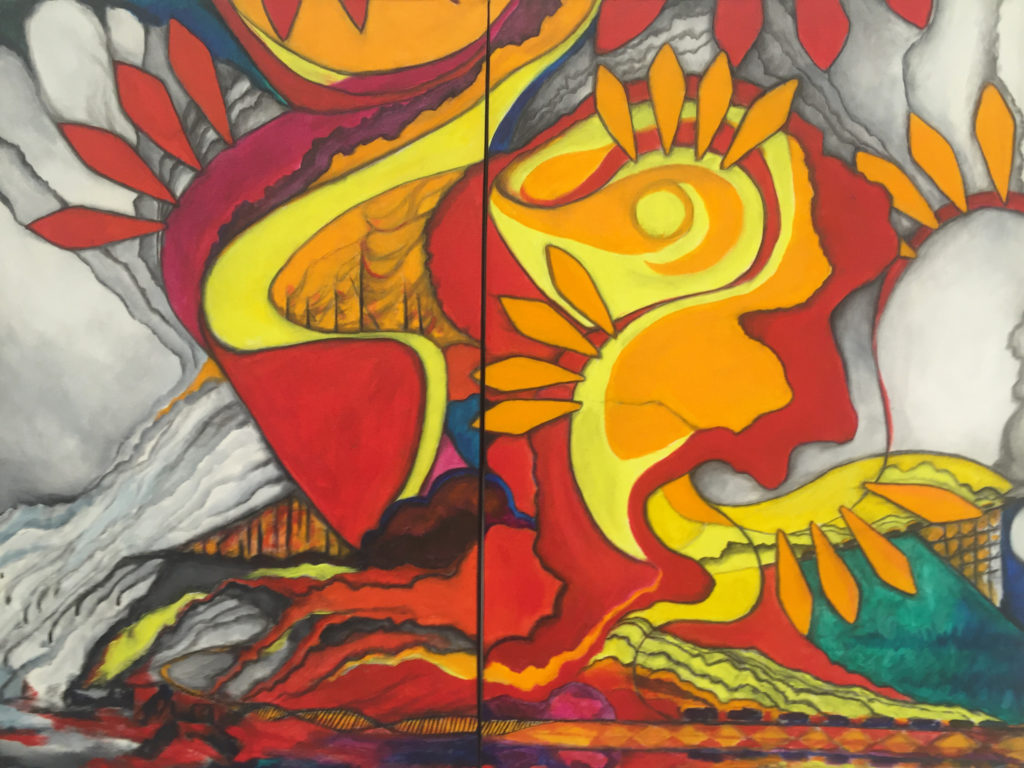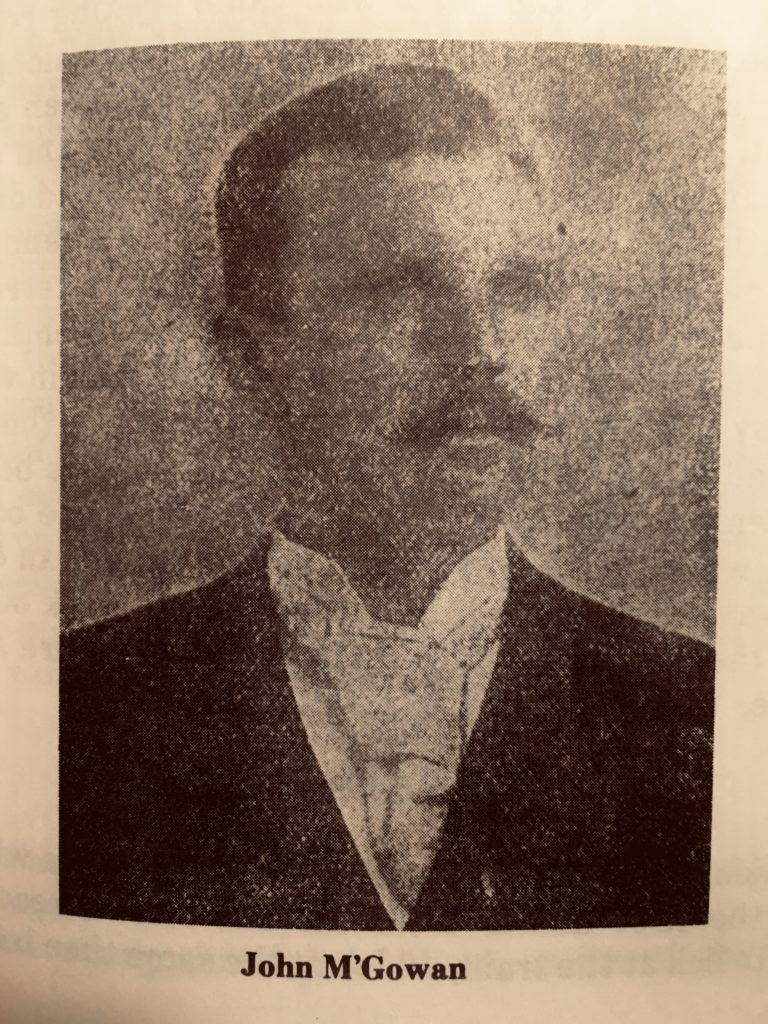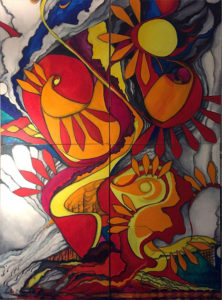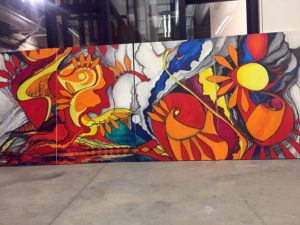Three Trains is currently on exhibit at the Minnesota History Center


My art usually is inspired by stories. Stories about the topic of climate change as a human caused global disaster relates very well to my installation “The New Climate” which is based on the story of Minnesota’s greatest human caused environmental disaster “The Great Hinckley Fire of 1894”. As a special education teacher in a St Paul school, the 6th graders I work with have a history day project that they can submit and advance to a state competition. A few a years ago, one of my more inquisitive students asked “What is your History Day Project?” If I had one? What would it be? To my student I answered The Hinckley Fire, and none of my students and many of the adults in the classroom had not even heard of the Hinckley Fire that occurred in 1894. The Hinckley Fire was part of my grandfather’s family stories told to me as a young child. In his words “we had a relative in that fire that was part of the history books”. I never thought about it much until this time because I was also invited to participant in a collaborative art exhibition at the Hinckley Fire Museum. In Working with the Fire Museum, I also initiated four of the artist from that collaboration into a self co-curated exhibition entitled “The Great Hinckley Fire of 1894: The New Climate.
I had added the by-line The New Climate to the show after making the connection of humans today causing climate change to Minnesota’s greatest human caused ecological disaster to date.
ClimateGEN Story MBG
THREE TRAINS
The Three Trains piece the exhibition was based on the three trains that encountered the fire that afternoon, two of which most people
survived and one where the passengers and train didn’t
make it out. In researching the train routes, I came across a recently published paper about the GIS mapping the physic scar of the Hinckley Fire. The mapping was completed in 2015 and was the basis for a painting on how severe the fire storm was burning 480 sq mi in 4 and a half hours. Eleven communities were destroyed and close to 500 people were killed not counting the tribal communities in the area. In researching the human stories of survivors, the book titled Eld Cyclonen originally published in Swedish in 1894 but later translated to English, gave first hand accounts of the most amazing tales of survival during the fire. Also, to my surprise the picture of my grandfathers relative John McGowan who was as it turns out to be the fireman on the train from Duluth. The following excerpts from Eld Cyclonen:

p.32
Two trains from Duluth arrived on the Eastern Minnesota line and on the first train rescued about 500
persons who otherwise surely have perished. The
second train arrived at 4:05 but because of a burnt out bridge could only proceed about a mile from town. Nevertheless, here gathered about 100 refugees who were taken aboard the train and after a hot race with death successfully reached the swamp, Skunk Lake, and were saved while, while the rescuing train , only a stones-cast away went up in smoke and ashes in a few minutes.
p.47-49
This train came from the Northland was due at Hinckley at 4:05 pm James Root the resolute and brave engineer, guided the locomotive with a sure eye and steady hand and it seemed heedless of his own mortal danger. Through all this confusion and emotional suffering the engineer James Root remained unmoved at his job, a genuine hero in mind and deed. The fire swept in through the windows of both sides of his cab., singeing his hair and half skinning his hands and face. Yet he kept on. Not even when his clothing caught fired did he show any inclination to give up, but with an amazing calm instructed the fireman John McGowan to pour water over him, and with a firmer grip on the throttle, he guided the burning train at a speed of 60 mph in the direction of the place refuge.
These were the first hand account stories which inspired the painting “Three Trains” but as the painting evolved it clearly was the ferocity of the fire that inspired me. Fire as a result of the early settlers years of disastrous logging practices that provided the fuel for such destruction and death. Even with smaller fires preceding that summer, only one man, General Christopher C. Andrews, looked to warning signs of how bad the duff buildup was on the forest floor and piles up next to train tracks. Humans could have prevented the fire and subsequent forestry practices were developed and mandated.
“How an active sentiment can be awakened for preservation of Minnesota timber I don’t know, as the present sentiment is to ‘grab all you can’ and no one cares about the future.”
George Goodrich, fire warden, Becker, Minnesota, January 13, 1896.
p.2 from the paper General Christopher C. Andrews: Leading the Minnesota Forestry Revolution by Anna M. Rice
During Minnesota’s early years, its most influential people were lumbermen, such as Frederick Weyerhauser and John Pillsbury. Pillsbury was governor, 1876–1882, as were lumbermen David Clough, 1895–1899, and Samuel Van Sant, 1901–1905 (Governors). The legislature favored lumber, too (Legislative 581-644). Lumber ruled Minnesota; virtually no laws controlled it.
Disaster loomed ahead. By 1890, entire forests fell: 2 billion board-feet annually — enough to circle the earth with an inch-thick floor, 14 feet wide. At this pace, only a decade of trees remained. There was no replanting, but even had there been, trees take 80 years to mature (Dunnell 8–11; Prout 79). Unscrupulous lumbermen chopped timber they didn’t own, especially on Indian land. Loggers littered the ground with branches and scraps, called slashings, that were easily ignited by locomotives, lightning, and careless people (Andrews “Autobio” 233.2, AR 1908 6).
In researching papers and data about the Hinckley Fire I began to see my grandfather’s stories of his family members past, becoming a warning to me and my children of the future. An message from a past generation to their descendants, making it clear to me that Climate Change was our “Hinckley Fire” of a possible future if we do nothing.
Thus the title for my instillation was determined. “The New Climate”. Since the spring of 2016 when I finished the burned trees of the “New Climate” piece, forest fires and flooding have dominated the media in our nation for the past 3 years. Broadcast footage from of California, Colorado, Arizona, and Montana like never seen before of fire engulfing whole communities.
I am honored to exhibit my art for ClimateGEN events on behalf of intergenerational lessons that our ancestors have given us to help our future children. My generation is now the one passing the stories on and My stories are through my visual art.

